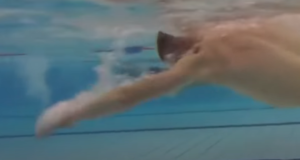In part one, I started discussing sinking legs. The reasons I noted were:
- Muscle density / Floating Position
- Head position
- Core (abdominal or dorsal muscle action)
- Kicking technique
- Ankle position / flexibility
- Arm action at entry
- Lack of kicking
I discussed the first three, and will now continue with the remaining items as well as give you a few links that I’ve found helpful
Kicking to Propel or to Balance
As a lazy swimmer, I’ve always thought that any action that doesn’t propel you forward should either be avoided or minimized. In the front crawl, the kick offers opportunities to increase propulsion (minimally) and help you balance your body in the water. When swimming longer distances, you’ll want to expend the minimal amount of energy to keep your legs from causing drag. The best way to do this is to think about three things:
- Where are you pushing water with your feet.
Ideally, you’ll want to push the water about 45 degrees down and back.

- Keep the kick behind the body.
Your feet and legs should only go slightly above and below your body. This will minimize the amount of drag created by the start and finish of your kick

- Focus energy behind you.
The drive of the kick is when you are kicking down from the hip through the leg.
The action of raising your legs up can be thought of as the recovery of the kick and very little propulsion is created in this action. (In fact, it can actually cause you to sink.) So, relax and just enjoy the swim.
Kicking is simple and should be easy. Think about why your kicking, primarily for balance, and focus the energy to that purpose.
Your Ankles Know What To Do
You’ve probably been told to point your toes when kicking in order to get the right action. But, if you don’t have any issues with the range of motion in your ankles, just relaxing your ankles might actually give you the shape you want. Specifically, as you drive your leg down with a little effort and nearly-straight knees, the top of your foot will push against the water and your toes will naturally point.
If your flexibility won’t allow your ankles to flex in this way, then you may need to consider minimizing your kick so that less of your legs and feet are exposed behind your body to create drag.
All of that Sculling Really Helps
As discussed last week, every action will cause some other reaction in the water. It follows that if you push water down with your arms and do nothing to offset that action, then your feet will sink. In fact, the further away from the center of your body, such as the start of your stroke, the greater the impact to your body position and your feet. Consider these two images:


In the top image, you can see that the hand is pointed roughly towards the bottom of the pool This means that most of the water is being driven down, driving the upper body up and the feet down.
In the second image, the hand is pointed directly towards the feet. This means that all water is creating propulsion forward.
Sculling-related drills, especially straight-armed sculling, help you learn to generate propulsion by directing the water towards your feet in a focused way. There is a reason to practice sculling.
I’ll be talking a bit more in the future about sculling as well as early vertical forearm (EVF) swimming.
Kicking Does Help
While I have noted that kicking offers only a miniscule amount of propulsion over long distances, it does help you focus other propulsion by balancing the body. In fact, a decent and focused kick can hide a multitude of other weaknesses in your swimming. For example, if you have a weak core, then rotating the body can be difficult for you. However, if you use your kick to help rotate your body, you can hide that weakness. If you find you need to raise your head more often to sight, you can focus kicking specifically when you raise your head in order to keep your body balanced. Based on your own stroke, you can determine if you need to kick an even or odd number of times per arm motion.
Drills can help you isolate how kicking impacts your swimming. Just as you can with your arm actions, isolation drills, such as kicking with only one leg, can help you find weaknesses in your swimming technique.
Summary
I hope that this give you something to think about next time you get that sinking feeling in the water. The position of your feet is probably a symptom of some other action in the water. Perhaps this information can help you identify the one cause, or likely several combined reasons, of your sinking legs.
As promised, here are some links that show some of the topics I’ve discussed here.
- https://www.220triathlon.com/training/swim-training/how-to-stop-your-legs-from-sinking-in-the-swim/
- Effortless Swimming
I really like their demonstrations- A smooth 100: https://www.youtube.com/watch?v=wvVZZy-8fv4
- Global Triathlon network:
- 4 ways to improve freestyle kick: https://youtu.be/5CPuOgPMvMc
- How to do freestyle kick: https://youtu.be/5CPuOgPMvMc
- How to stop your legs from sinking: https://youtu.be/fJW4nqaSoJg
- Speedo Freestyle Kick: https://youtu.be/KK563K_DZP0
